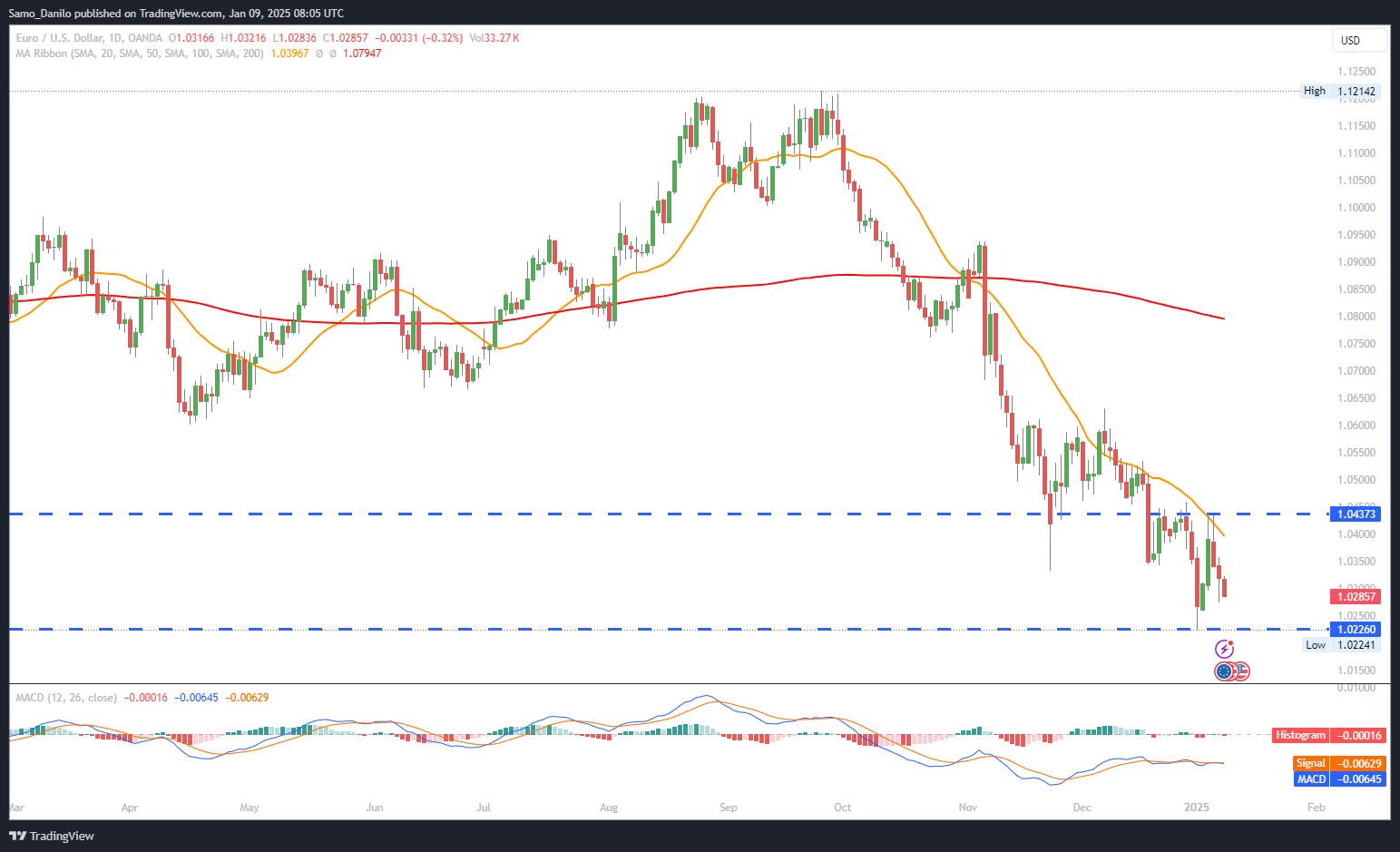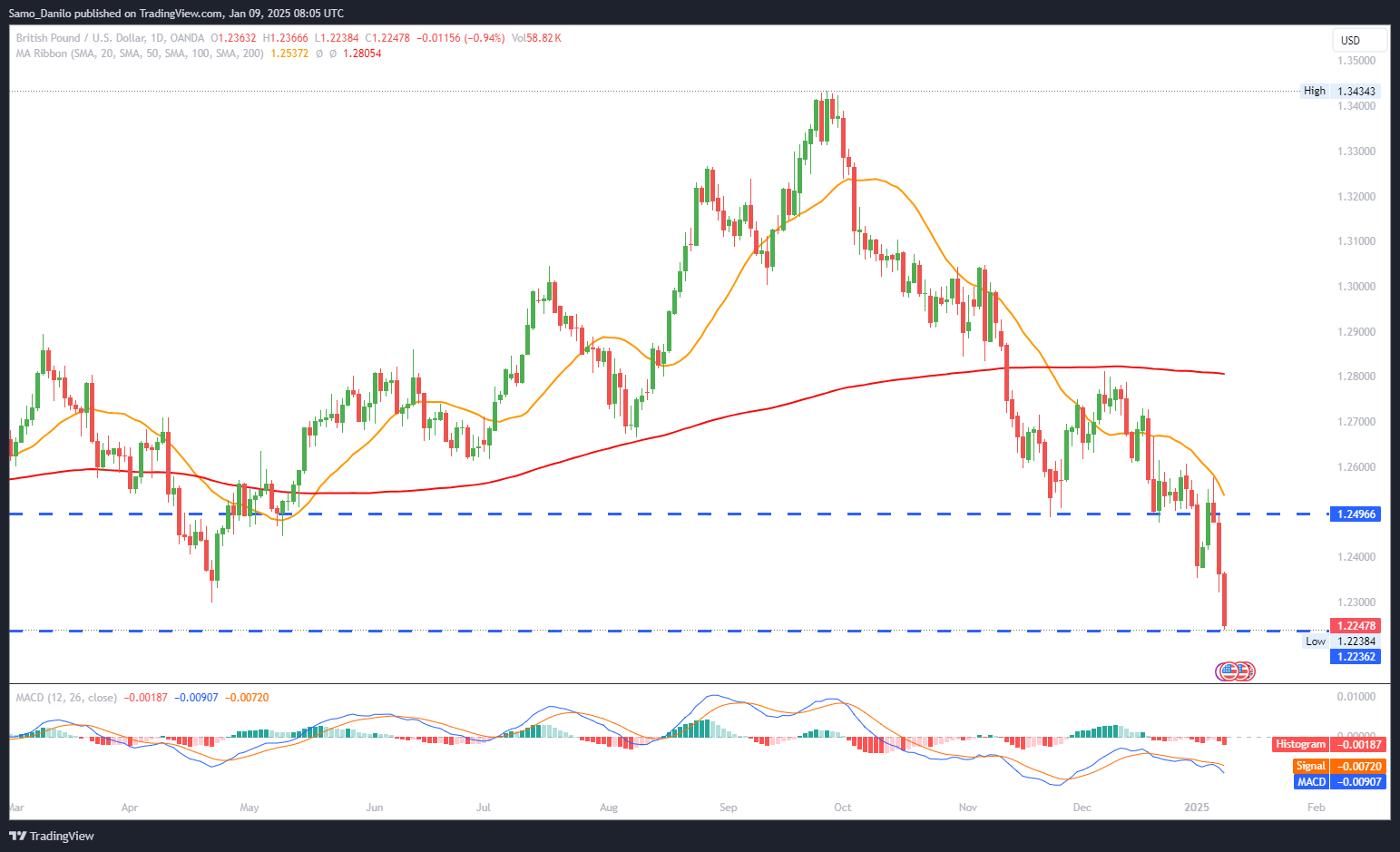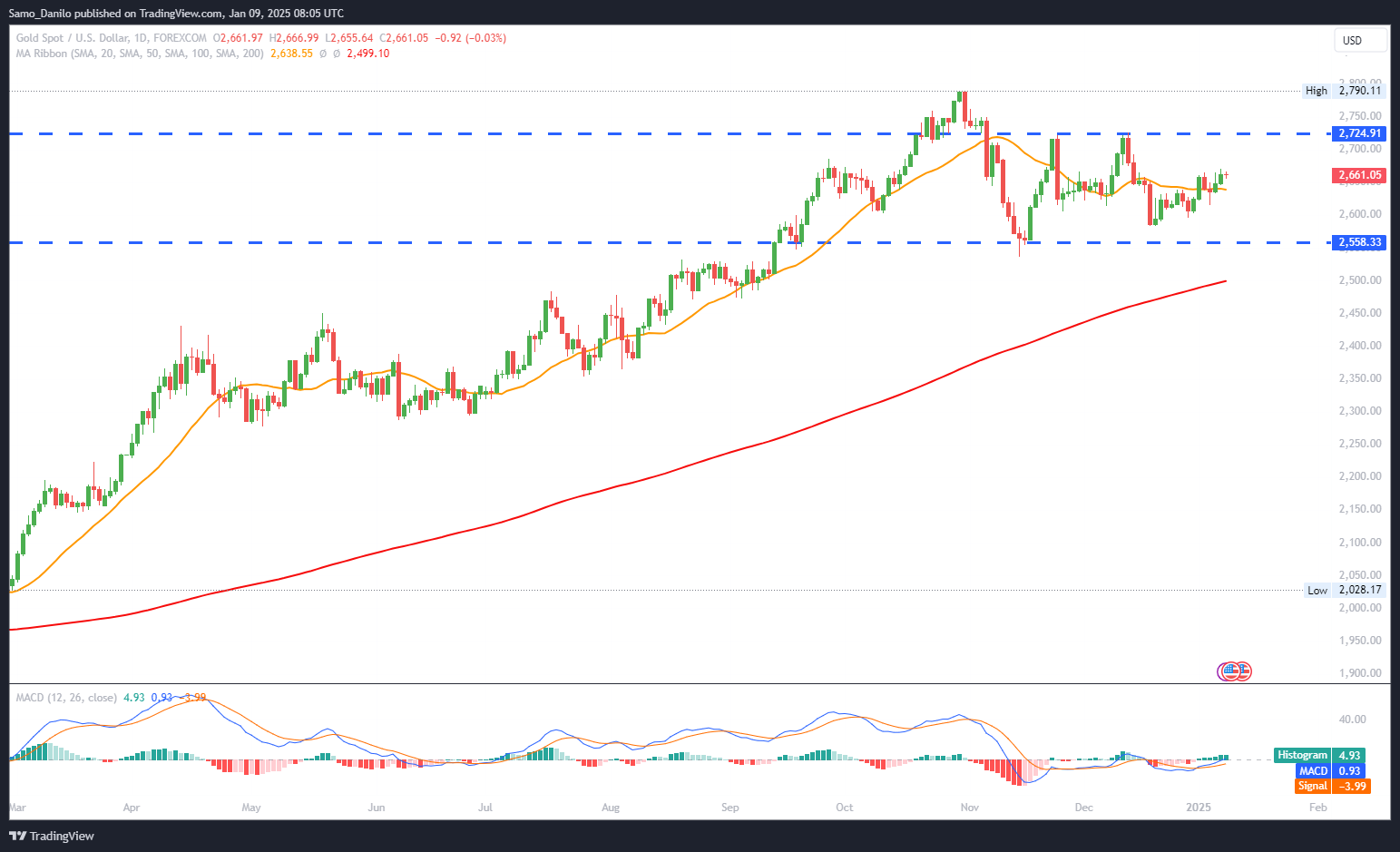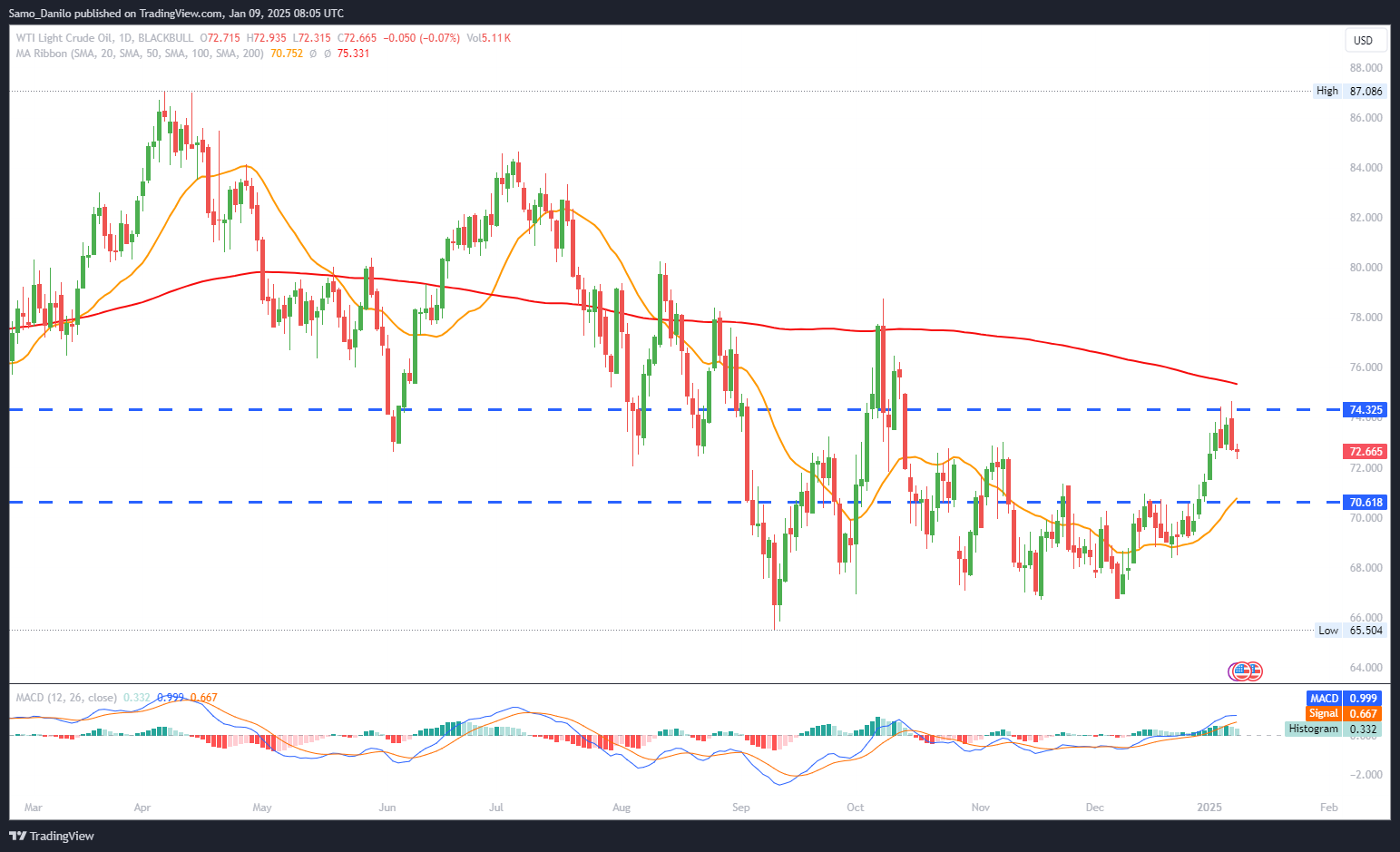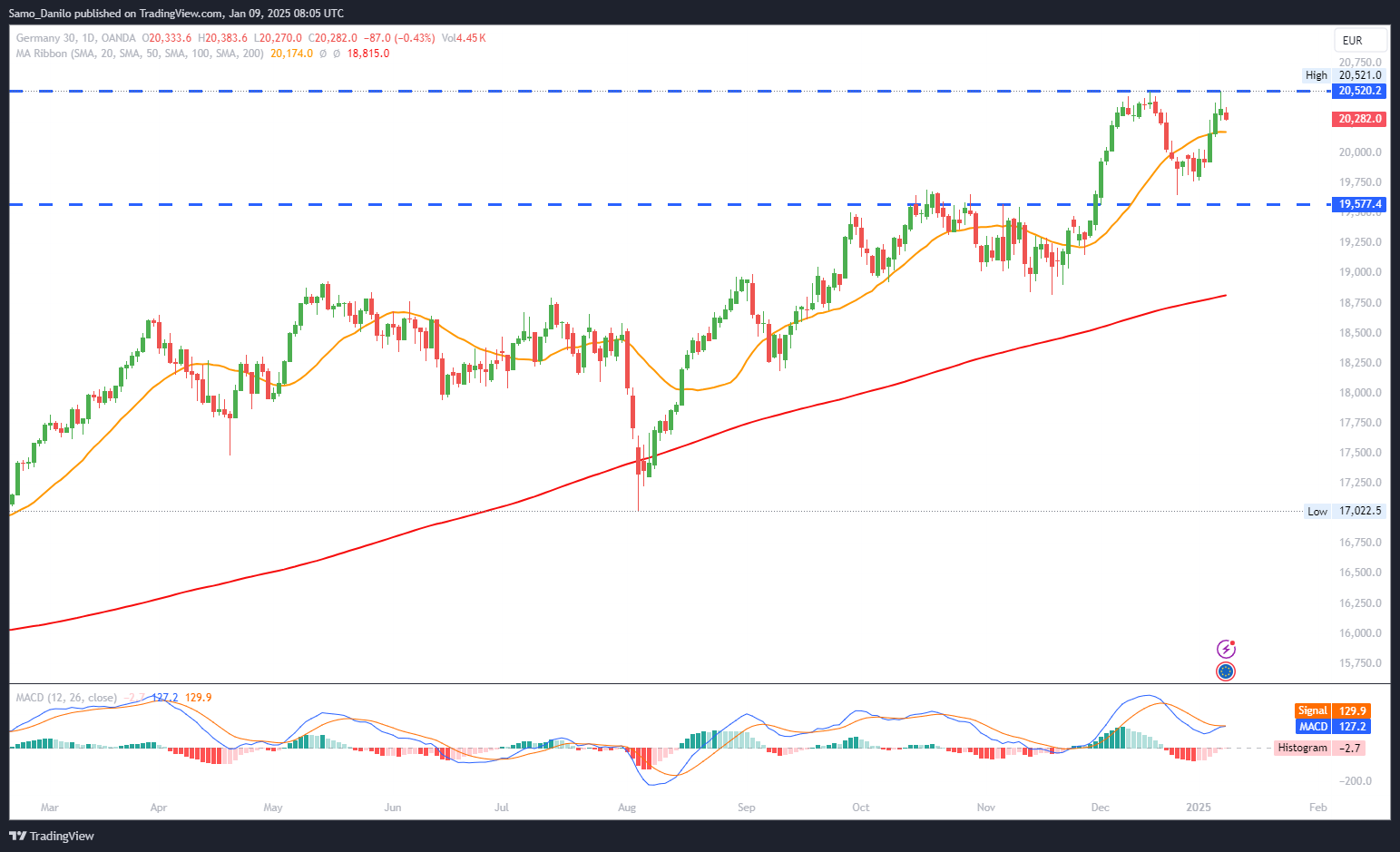EURUSD
- EUR/USD Price: The EUR/USD pair continues its downward trajectory, trading near 1.0300 during Thursday's early European session. Persistent selling pressure stems from weak German economic data and expectations of aggressive rate cuts by the European Central Bank (ECB) in 2024.
- German Factory Orders: November Factory Orders in Germany showed a sharp decline, signaling ongoing weakness in the Eurozone's largest economy. This, coupled with the market's pricing of multiple ECB rate cuts this year, has left the Euro vulnerable against the US Dollar.
- US ADP Report: The US ADP Employment Report revealed that the private sector added just 122K jobs in December, falling short of the 140K forecast. Despite the softer data, the Euro struggled to recover, reflecting broader pessimism surrounding the Eurozone economy.
- Fed’s Outlook: Minutes from the Federal Reserve’s December meeting revealed concerns about interpreting inflation data under President-elect Donald Trump’s trade policies. Fed officials advocated for a measured approach to monetary policy in the upcoming quarter, maintaining focus on data-driven decisions.
- Eurozone and US Data: Investors will closely monitor Eurozone Retail Sales data for November, as any further signs of economic weakness could amplify bearish pressure on the Euro. Additionally, remarks from Fed officials later in the day are expected to offer insights into the US monetary policy outlook.
Closing statement: The EUR/USD remains under pressure, with weak German data and dovish ECB expectations driving the decline. Traders will focus on Eurozone Retail Sales and Fed commentary for further directional cues, as the pair remains vulnerable to downside risks.
GBPUSD
- GBP/USD Price: The GBP/USD pair remains on the backfoot, trading below the 1.2300 mark during Thursday's European session. The ongoing bearish momentum marks the third consecutive session of losses as the pair struggles to regain bullish footing.
- Technical Indicators: From a technical perspective, the pair continues to trade within a descending channel pattern on the daily chart, reinforcing a bearish outlook. Failure to break above key resistance levels signals potential for further downside in the short term.
- US Initial Jobless Claims: The US reported Initial Jobless Claims for the week ending January 3 at 201K, better than the forecast of 218K and lower than the prior reading of 211K. Despite the positive labor market data, the GBP/USD pair remained largely unaffected.
- Fed Minutes: Minutes from the Federal Reserve’s latest meeting revealed heightened concerns among policymakers about President Donald Trump's proposed tariff policies. This dovish tone from the Fed added to market caution, keeping the US Dollar's bullish momentum in check.
- US Labor Market Data and Fedspeak: Market participants will closely watch Challenger Job Cuts data and speeches from several Federal Reserve officials later in the day for potential trading cues.
Closing statement: GBP/USD continues to face downside risks amid technical and fundamental headwinds. With key US labor market data and Fed commentary on the horizon, the pair is likely to remain vulnerable to further declines, barring any unexpected bullish catalysts.
XAUUSD
- Gold Price: The gold price advanced during the North American session as the Federal Reserve’s December meeting minutes revealed a neutral to slightly hawkish stance. While the tone raised uncertainty over the pace of future rate cuts, it provided modest support for XAU/USD.
- Tariff Speculations: Reports from CNN suggest US President-elect Donald Trump may invoke the International Economic Emergency Powers Act (IEEPA) to declare a national economic emergency and implement new tariff measures. This uncertainty could bolster gold’s appeal as a safe-haven asset in the near term.
- Strong US Data: Elevated US Treasury bond yields and robust economic data—such as the JOLTS Job Openings survey, Initial Jobless Claims, and ISM Manufacturing and Services PMI—have driven US Dollar strength, limiting gold’s upward potential. These factors continue to support expectations for fewer rate cuts by the Federal Reserve in 2024.
- China’s Inflation: China’s Consumer Price Index (CPI) inflation slowed to 0.1% annually in December, while the Producer Price Index (PPI) declined by 2.3% YoY. The results, aligning with market expectations, suggest a subdued inflationary environment, impacting gold demand from the world’s largest consumer.
- Fedspeak: Traders will closely monitor speeches from key Federal Reserve officials, including Richmond Fed President Tom Barkin, Kansas Fed President Jeffery Schmid, and Fed Governor Michelle Bowman, for additional clarity on the US central bank's monetary policy trajectory.
Closing statement: Gold remains caught between supportive geopolitical factors and headwinds from a strong US Dollar and rising bond yields. The precious metal's near-term outlook will depend on upcoming Fed commentary and market reactions to geopolitical developments, particularly those involving tariff policies.
CRUDE OIL
- WTI Price: West Texas Intermediate (WTI) crude oil trades around $73.20 on Thursday, pressured by the recent strength of the US Dollar. Currency dynamics have made oil less attractive for holders of other currencies, adding downward pressure to prices.
- US Crude Inventories: The US Energy Information Administration (EIA) reported a decline of 959,000 barrels in crude oil inventories for the week ending January 3, marking the seventh consecutive weekly drop. This trend underscores tightening domestic supply, which could provide a floor for oil prices in the near term.
- Geopolitical Tensions: New sanctions targeting Iranian and Russian crude exports are expected to tighten global oil supplies. With additional measures planned by the Biden administration ahead of Donald Trump's inauguration, the market anticipates disruptions that could elevate oil prices.
- Chinese Port Restrictions: Reports suggest that a port operator in Shandong, China, has instructed ports to reject tankers sanctioned by the US. This directive could hinder Iranian crude shipments to major refiners in the region, further straining global oil flows.
- Fedspeak and Data: Oil traders are closely monitoring upcoming Federal Reserve speeches for insights into monetary policy. Additionally, Friday’s US employment data for December will be pivotal, as labor market trends could influence oil demand forecasts and broader market sentiment.
Closing statement: Crude oil prices remain under pressure from a strong US Dollar, but supply-side factors—such as declining US inventories and escalating sanctions—offer potential upward momentum. Market participants will seek clarity from Fedspeak and employment data to gauge the broader economic outlook and its implications for oil demand.
DAX
- Technical Outlook: The DAX continues to show strength, trading comfortably above its 50-day and 200-day Exponential Moving Averages (EMAs). This technical setup confirms a bullish market trend, with investors showing confidence in the index’s upward momentum.
- European Market Sentiment: European markets have turned optimistic this week, supported by Monday’s Eurozone CPI report. The inflation data met expectations, reducing fears of both overheating and stagnation, thereby stabilizing market sentiment and supporting equity markets like the DAX.
- German Industrial Sector: Germany’s industrial production showed a strong rebound in November, increasing by 1.5% month-on-month, according to Destatis data. This recovery signals resilience in the industrial sector, providing additional support to the DAX.
- German Trade Balance: German exports rose by 2.1% in November, while imports declined by 3.3% on a calendar and seasonally adjusted basis. The improved trade balance underscores stronger external demand and easing domestic cost pressures, contributing to market optimism.
- US-China Trade Tensions: Escalating trade tensions between the US and China remain a potential headwind. China’s announcement to limit exports of key metals for battery production could affect global supply chains and weigh on market sentiment if unresolved.
Closing statement: The DAX continues to benefit from bullish technical trends and positive economic data, particularly from Germany’s industrial and trade performance. However, geopolitical risks like US-China trade tensions could dampen the outlook. Investors will likely monitor global trade developments and economic indicators for further direction.
